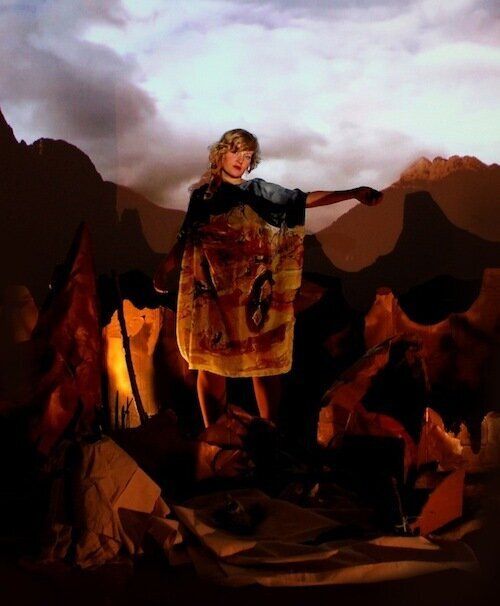As a child, Clare Carter built miniature landscapes on the shelves in her Yorkshire bedroom, but the environments she has encountered on artist residencies in the Norwegian fjords and Arctic Greenland are even more fantastical than her childhood creations.
Carter's understanding of landscape is multiple. It can be "inner and outer, physical and psychological, inhabited and uninhabited." She has mapped "the pathways and entry points between these worlds" using painting and, more recently, music as The Horn The Hunt, with composer/musician Joe Osborne.

Carter's work expresses curiosity about the ways humans adapt to different environments. Her interest in animist belief and ritual might suggest a preexisting sympathy with Inuit culture. Did she feel at home in Greenland during her residency at Upernavik Museum? "When I arrived, I was completely shell-shocked by the frightening environment. I couldn't contemplate the vastness of the landscape. I spent most of my time in Upernavik looking through books about north-west Greenland and its people. They contained mainly black and white photos, some very old. These photographs of people and the landscape made a visual link between myself as a westerner and the brutal nature of Greenland."
After initial concern over how to communicate this wild landscape on canvas, Carter began painting the photographs. The process helped her to understand her interest in illusion, as well as the role of performance and exhibition in her work. "If we can't understand what is different about other cultures we have to make small reconstructions or dioramas. Perhaps by taking the exotic and putting it through our own fabricating process we can begin to contemplate its reality."
The Cave, painted in Norway, places experiences and landscapes in a situation where they can be viewed as performance. Carter explains, "It's a modern cave painting. A man sits at a desk making music. The unfamiliar and unexplored landscape penetrates the room so that he is absorbed into it. The room and the landscape toy with each other for control of the stage."

Carter's painting, already veering toward the internal, the performative, was challenged by the residencies in the north. "The hardest thing about living in the darkness is that you have no view, no way of projecting emotions outwards. There is no landscape to absorb or give perspective on existence, except that of the domestic space. It's like being in a cell - you know there's space and life outside but you have no visual access to it. The only visuals are man-made: the electric light illuminating a path; lamps glowing inside a living room; the television projecting scenes from places with daylight. In a sense, everything becomes imaginary, an illusion - or if not an illusion, a human fabrication of 'day' in a nocturnal world."
While the Norwegian landscape blurs with domestic space in The Cave and other paintings, the Arctic landscape entered Carter's work even more intimately, as music. She dates her emergence as a composer to the winter in Upernavik: "One particularly dark day, Joe started playing this bass line with a sensual guitar effect. It seemed to merge with the silent inkiness of our surroundings. We had been encased in night for weeks, and things had started to get internalized. We had started to rely on sound more. The house we lived in was right next to the sea and the sound of the waves was a soothing omnipresence that seemed to wrap around us like a constant wind. We took some recordings of the sea and Joe manipulated them to be kind of percussive, but also elastic. I wrote a vocal line about leaving my old self behind and starting again. We didn't realize it at the time but this was to be the first song we would write as The Horn The Hunt."
The song was Whale's Belly (Eclipse), which was released in December accompanied by a film shot in Upernavik's semi-darkness. The listener needs patience to interpret the visual and musical nuances emerging from the dusk. The action that plays out in the darkness might best be described by the Greenlandic verb "iimivoq", which can be interpreted as either "water is drawn from the shore by the ebb of the sea" or "to call out for joy." The tide sighs under the ice, rising and falling, almost indistinguishable from the singer's breath. In this, as in other releases, The Horn The Hunt create a chilling union of human and earthly landscapes.
Picture credit:
Clare Carter, The Cave, 2008.
250 x 130 cm
Oil & acrylic on canvas
